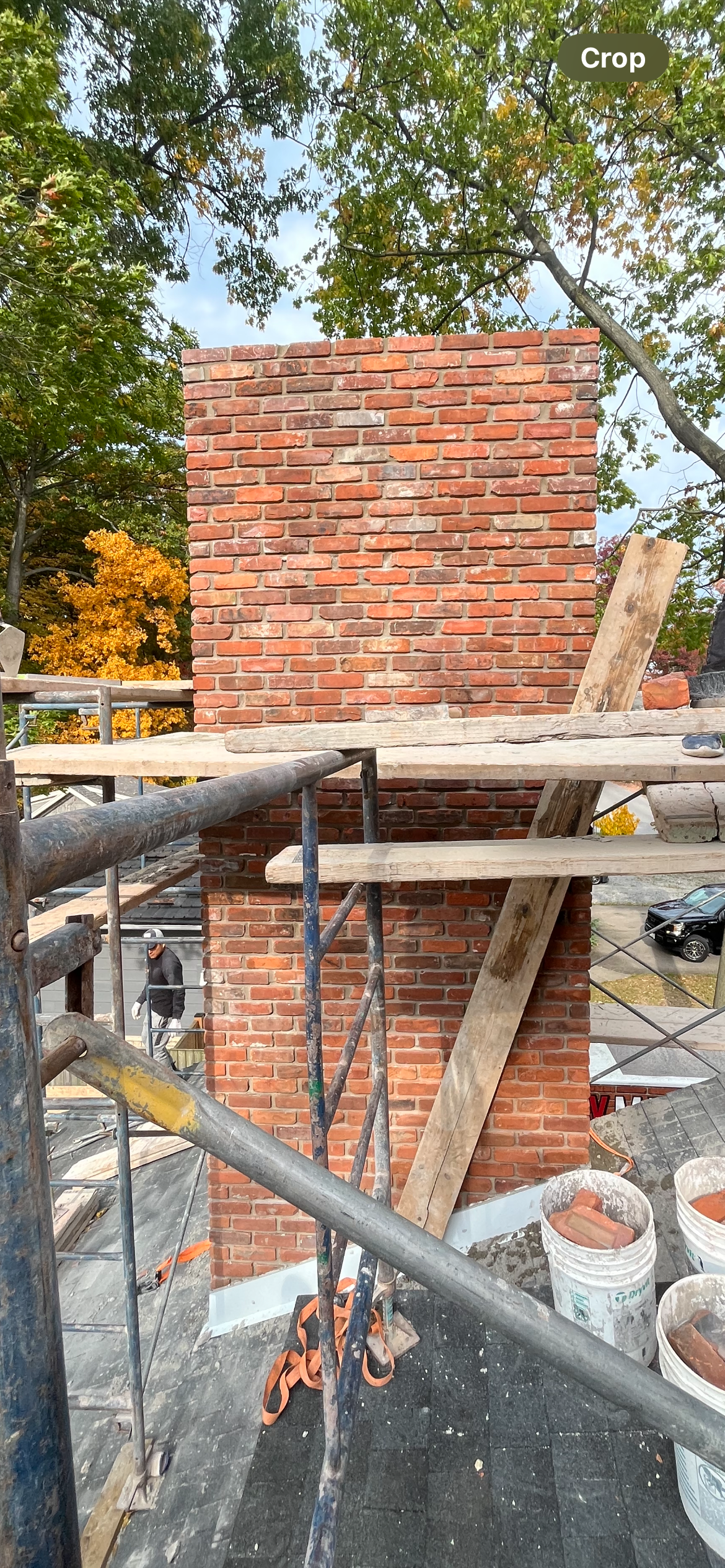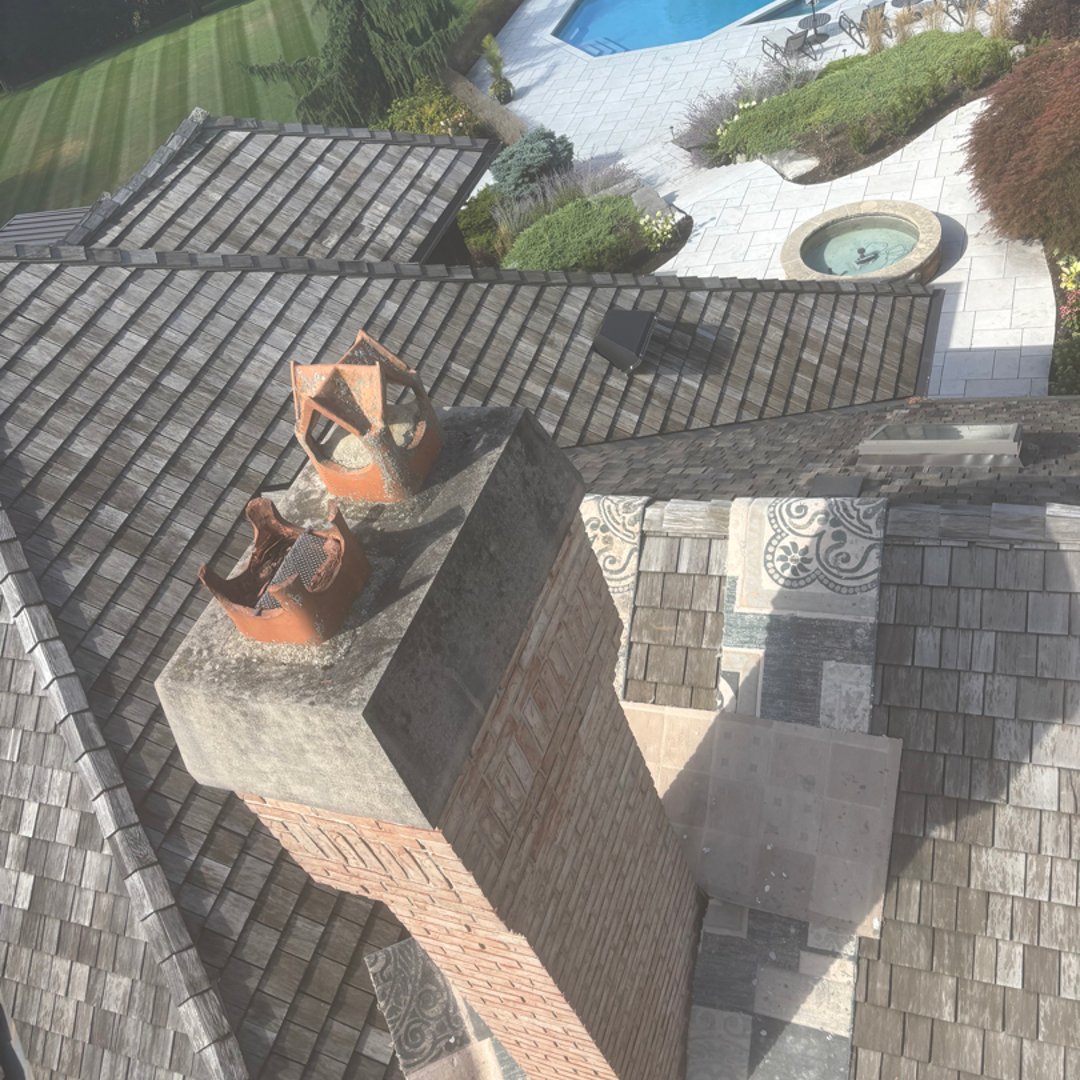
We Assess the Problem
We inspect the damage, identify what caused it, and plan the fix. No shortcuts—just a clear path to doing it right.


Real chimney repairs from across Ontario. Swipe to see more photos.








Full chimney rebuild with new flue tile, concrete cap, and flashing repair.






Rebuilt both chimneys with stone matching, new caps and flashing.





Rebuilt 8 courses on face and 3 on back with Riverdale Rug Ontario brick.





9-course rebuild with decorative sill caps, new flues, and waterproofing.






Removed and replaced top 11 courses with new decorative concrete sill caps and waterproofing.






Rebuilt both chimneys from flashing up with matching heritage brick and new concrete sill caps.
Brick damage doesn't fix itself. Spot these warning signs early to avoid expensive repairs later.
Water stains near your chimney, musty smells, or active dripping during rain signal failed flashing, crown damage, or open joints. This causes interior damage, mold risk, and accelerating structural issues.
The cement cap on top cracks from freeze-thaw cycles, letting water seep directly into the chimney masonry. This is the #1 cause of chimney leaks and must be addressed before interior damage spreads.
Brick faces popping off or crumbling indicate moisture trapped inside froze and expanded. Ontario winters accelerate this damage—pieces falling means deterioration is spreading to surrounding bricks.
Seeing any of these? Get a free assessment.
Chimney repair restores the watertight integrity of your chimney stack—fixing the crown, flashing, mortar, and bricks that keep water out.
Most homeowners notice leaks or staining first. We trace the source, repair the damage, and waterproof the stack so it handles Ontario freeze-thaw cycles.
Water stains
Staining on ceiling or walls near chimney.
Visible damage
Cracked crown, missing mortar, or flaking bricks.
Musty smell
Moisture trapped in flue causes odor.
The original crown was cracked and the decorative chimney pots had deteriorated. We poured a new concrete crown and sourced custom terracotta pots to match.

BEFORE

AFTER
Small repairs prevent expensive damage
A leaking chimney causes mold, wood rot, and ceiling damage. Fixing now prevents costly interior repairs.
Water weakens mortar and brick. Left alone, sections crumble and require full rebuilding.
Cracked crowns and missing mortar look neglected. Repairs restore your chimney's appearance.
A small crown crack becomes a major water damage problem in two freeze-thaw cycles.
Our Process
Transparent process, quality results. Here's what to expect.

We inspect the damage, identify what caused it, and plan the fix. No shortcuts—just a clear path to doing it right.

Clean prep, proper materials, careful execution. We're detail-oriented because the small stuff determines how long the work lasts.

Repairs that blend in, a site you'd never know we touched, and a warranty you can count on.
Clear documentation of what's included in every project
We let you know when we're coming, what we're doing, and when we're done
We review the finished work together before sign-off
Ready to get started? Book a free on-site estimate.
Schedule EstimateBrick and mortar matching so seamless, you can't tell where we worked.
Same trained team on every job. No middlemen, no surprises.
Drop cloths, dust control, daily cleanup. Your yard stays as clean as we found it.
Something not right? We come back and fix it. In writing.
4.9★ average. See what your neighbours say.
We quote after inspection - here's what we assess
Flashing fix vs. crown rebuild vs. full stack repoint - each has different scope.
Localized mortar loss costs less than full chimney deterioration.
Multi-story chimneys or steep roofs require more staging and safety equipment.
Heritage homes need period-appropriate brick and lime mortar, which takes more time.
If damage extends to the flue liner or smoke chamber, those add to scope.
Most repairs cost less than you'd expect—and far less than ignoring the problem. **Project Complexity:** - **$ Small repairs** — Crown sealing, minor repointing - **$$ Medium repairs** — Partial brick replacement, flashing - **$$$ Large repairs** — Extensive repointing, multi-section rebuilds - **$$$$ Full chimney rebuild** — Above roofline reconstruction Final pricing depends on height, access, materials, and scope. We provide written quotes with itemized pricing after inspection.
Your Quote Includes
Free on-site quote · No obligation
800+ reviews
They replaced my entire chimney and you wouldn't even know it was replaced. The bricks matched so well. They left the yard very tidy and neat. Very pleasant respectful workers.
Janet D.
Fix My Brick repaired the top of my chimney. They had a great price. They were able to repair it in a timely fashion. Their work was superb. I cannot recommend them enough.
Kyle A.
Ryan and Polo did an incredible job with our chimney today! They matched our brick perfectly, you can't even tell where the old part ends and the new part starts.
Bridget C.
Everything you need to know before getting started.
Explore related services, locations, and helpful guides from our masonry experts.
4 services
6 locations
2 articles
Not sure if your chimney crown needs repair or replacement? Learn the warning signs, why crowns fail, and what a lasting fix looks like.
What does chimney damage actually look like? Fix My Brick crews share the warning signs they check on every inspection—based on 1,000+ chimney assessments across Southern Ontario.
Local crews serving the GTA and Golden Horseshoe. Travel is covered within the cities below.
14 cities
8 cities
6 cities
10 cities
11 cities
12 cities
17 cities
Don't see your city? Contact us - we likely serve your area. Contact us to check if we cover your area.
Ready to Get Started?
Book your estimate online in minutes. Pick a time, upload project photos, and you're confirmed instantly. No phone tag required.